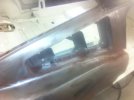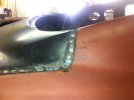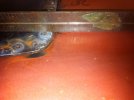Back when I did this, I first plug welded with about the same amount of plug welds as spot welds.
I later went back and continuously welded the over lapped edges, I don't have pictures after that step.
I then just used regular Rage Gold over the seam. Do I need to dig the rage gold out, either fill with metal and re-do the filler, or just use a different type of filler?
Note this is a 6 CYL auto car and won't be on the track or anything.
The seams I'm talking about are at the roof and the 1/4 to transition panel. Pictures after just the plug welds, but before the continuous welds:
I later went back and continuously welded the over lapped edges, I don't have pictures after that step.
I then just used regular Rage Gold over the seam. Do I need to dig the rage gold out, either fill with metal and re-do the filler, or just use a different type of filler?
Note this is a 6 CYL auto car and won't be on the track or anything.
The seams I'm talking about are at the roof and the 1/4 to transition panel. Pictures after just the plug welds, but before the continuous welds:



